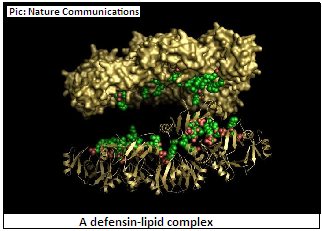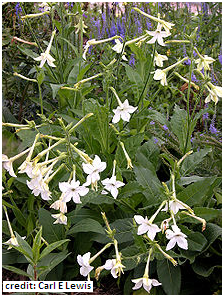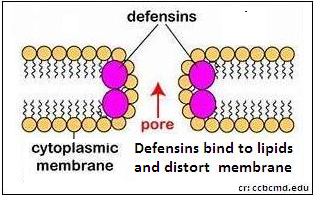Understanding how antibiotics work would help outwit resistant bacteria, says S.Ananthanarayanan.
When antibiotics were discovered, they promised freedom from many kinds of disease. What we did not allow for was that bacteria would find ways avoiding the new threat. Now, we have wide-spread misuse of antibiotics, which is not helping to contain the danger, and an alarm has been sounded of antibiotics being passed by and a ‘return to the dark ages of medicine’!
Michael Järvå, Fung T. Lay, Thanh Kha Phan, Cassandra Humble, Ivan K.H. Poon, Mark R. Bleackley, Marilyn A. Anderson, Mark D. Hulett and Marc Kvansakul, a team from La Trobe Institute of Molecular Science, Melbourne, Australia, report in the journal, Nature Communications, the mechanism of anti-fungal substances in a variety of the tobacco plant, which are effective against a leading antibiotic-resistant microorganism. The advance may lead to new ways and a second chance to fighting bacterial infection.
That some fungi and plants are effective against bacteria was known since ancient times. In 1928, Alexander Fleming discovered that a molecule, penicillin, was the active agent in many molds. While Fleming proposed that the molecule could be used in medicine, reasonably pure penicillin was extracted by chemists only in 1942 . Penicillin and some other similar molecules, now known as antibiotics, played a great role in saving lives of allied soldiers during World War II. Since then, there has been rapid development of natural and synthetic antibiotics preparations for dealing with specific as well as ‘broad spectrum’ bacterial infections.
Antibiotics are small molecules that affect parts of bacterial cells which are either not there in body cells or in different forms. One of the ways antibiotics act is by breaking down the bacterial cell wall. Another is by blocking vital processes, like DNA multiplication or the production of some proteins. Body cells do not have cell walls and have different internal processes. Antibiotics hence destroy or immobilize bacteria, but leave body cells comparatively unaffected. Viruses, which act mainly by taking over a host cell’s resources, have negligible internal processes and no cell wall. This is why antibiotics are not useful to treat viral infections.
But antibiotics do affect bacteria, and this is with the help of shape features of the antibiotic molecule that fit complementary features on or inside the bacteria. It is because of these shape features that antibiotics affect only specific bacteria. Some antibiotics affect many bacteria. These often affect body cells too and certainly affect the useful bacteria, such as those found in the intestines. The shape specificity, however, gives the bacterium an opportunity to change its vulnerable shape feature and escape the antibiotic’s attention.
If we take low doses of antibiotics or antibiotics when we do not need to, vulnerable bacteria do get killed, but occasional individuals, with chance features that do not match the antibiotics’ shape features, manage to escape. The result is that these infrequent but resistant bacteria begin to dominate, and in time, they go forth in numbers as a new, resistant strain. We then have an outbreak of a disease which used to be managed, but is now out of control, as the antibiotic of choice does not work. Scientists are hence constantly at work to discover or to develop new antibiotics that are effective against new strains of disease-causing bacteria. The work, however, is largely trial and error and hit or miss, as we do not have a deep understanding of the mechanics of the different ways that antibiotics work.
Apart from antibiotics that are isolated or synthesized in this way, however, animals and plants generate their own anti microbial substances, ‘as a first line of defense against pathogens’. “Essentially all plant and animal species produce substances, the ‘defensins’, which exhibit broad antimicrobial activity, as an important component of their innate immune systems,” the team at La Trobe Institute at Melbourne say in the paper. “Defensins have multiple mechanisms of action, including modulation of immune responses, triggering the production of reactive oxygen species, cell cycle interference, inhibition of enzymes and ion channel activity, as well as the disruption of membranes. Plant defensins can also play roles in root development and plant reproduction, underscoring the diversity of biological functions that can be meditated by this family of molecules,” the authors of the paper say. Extracts from different animals or plants have hence become important sources for dealing with antibiotic-resistant pathogens.

One of the key strategies that defensins employ to immobilize bacteria, the paper says, is to disrupt the membranes of the cell wall. The team refers to their earlier work where they had found that the action of defensins was by connecting with specific molecular portions, called phospholipids, associated with bacteria, and forming chains or nets that immobilized bacteria or made the cell walls porous. The paper says that there are some tentative ideas about how the defensins go about disrupting the cell wall, particularly the nature of the complex that the defensins form with the bacteria lipids.

The team has now taken up the case of defensins found in the plant, Nicotiana alata, an ornamental tobacco species which is also known as jasmine tobacco, sweet tobacco or winged tobacco. One of the defensins, the defensin 1 of Nicotiana alata, or NaD1, is known to attack Candida albicans, a kind of yeast that is toxic to some humans. To investigate the mechanism of the action, the team used transmission electron microscopy to study the crystal structure of the complex formed by NaD1 with the lipid, phosphotidic acid, and part of the Candida cell wall. The structure revealed by the study confirmed one of the proposed forms and also indicated the nature of pairing or combining of defensins with lipids. The action of NaD1 on Candida albicans was also studied using variations of forms of NaD1 and it was found that the forms where specific portions of NaD1 were modified lost the ability to suppress Candida.

The molecular pathway followed by defensins to deal with bacteria is different from the way usual antibiotics go about the task. Defensins could hence become an important new instrument to control bacteria that have found ways to evade antibiotics. The work of the Melbourne team has confirmed an important conjecture of the form of the defensin-lipid complex and then identified some detail of the structure of the defensin molecule that plays a pivotal role in overcoming bacteria defenses.
"It's an exciting discovery that could be harnessed to develop a new class of life-saving antimicrobial therapy to treat a range of infectious diseases, including multi-drug-resistant golden staph, and viral infections such as HIV, Zika virus, Dengue and Murray River Encephalitis," Mark Hulett, one of the researchers said.
------------------------------------------------------------------------------------------ Do respond to : response@simplescience.in